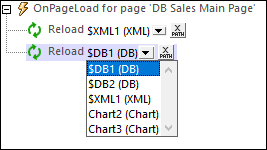Reload
Reloads the external resource specified in the action's combo box (see screenshot below). External resources referenced by the project are available as entries in the combo box, and include XML files, charts, and images.

Note the following:
•If the resource to be updated is a page source, then an XPath expression that locates the root node of the page source can be used (for example: $XML1 or $DB2).
•Notice that the screenshot above contains entries for chart controls. If selected for update, the chart image will be updated when the event is triggered. Image controls can also have their linked images updated with the Update action.
•Updates can also be triggered by control events. This means, for example, that when a combo box is edited, the OnFinishEditing event of the combo box can be set to update the image linked to an image control. See the Quick Start (Part 1) tutorial for an example of this.
•To reload multiple resources when the event is triggered, add multiple Reload actions, as has been done in the screenshot above.
Error processing
The On Error option lets you define what should be done if an error occurs. Since the error handling can be precisely defined for this action, errors on such actions (that provide error handling) are treated as warnings—and not errors. The advantage is that you do not need to check errors on actions for which error handling has already been defined. The following error handling options are available:
•Abort Script: After an error occurs, all subsequent actions of the triggered event are terminated. This is the default action if an error occurs. If you wish to continue despite an error, select either the Continue or Throw option.
•Continue: Actions are not terminated. Instead, you can select what to do in either event: when there is no error (On Success), or when there is an error (On Error). For example, you might want to display a message box saying whether a page load was successful or not.
•Throw: If an error is detected, this option throws an exception that is stored in the Try/Catch action's variable. The Catch part of the Try/Catch action is used to specify what action to take if an error occurs. If no error occurs, then the next action is processed. See the section Try/Catch action for details.
MobileTogether extension functions
MobileTogether provides a range of XPath extension functions that have been specifically created for use in MobileTogether designs. Some functions can be particularly useful with specific actions. For example, mt-available-languages() returns the languages in which the solution is available and could, for example, be used with the Message Box action. If a function is especially relevant to this action, it is listed below. For a full list of extension functions and their descriptions, see the topic MobileTogether Extension Functions.
mt-external-error-code()
mt-get-source-from-name()
mt-get-source-name()
mt-get-source-structure()